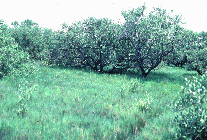Coastal Wetlands: Salt Marshes & Mangrove Forests
Most Common Wetland Plant Species at FMEL
Coastal wetlands (salt marshes and mangrove forests) are important components of estuarine and  coastal systems. These habitats often have extremely high primary production that fuels both terrestrial and aquatic food webs. In addition, wetlands contribute to estuarine water quality by removing excess nutrients and pollutants originating in the uplands before they reach the estuary. Wetlands offer important habitat for a wide variety of organisms including invertebrates such as crabs and shrimp, fish, birds and others, and provide protection against coastal erosion Many estuarine species of commercial importance rely on these habitats for succesfull completion of their life cycle.
coastal systems. These habitats often have extremely high primary production that fuels both terrestrial and aquatic food webs. In addition, wetlands contribute to estuarine water quality by removing excess nutrients and pollutants originating in the uplands before they reach the estuary. Wetlands offer important habitat for a wide variety of organisms including invertebrates such as crabs and shrimp, fish, birds and others, and provide protection against coastal erosion Many estuarine species of commercial importance rely on these habitats for succesfull completion of their life cycle.
Coastal wetlands along the Indian River Lagoon are relatively young, having developed less than 6,000 years ago on washover fans, or on tidal shoals of past and present inlets. On the north end of the lagoon, marshes are primarily vegetated with herbaceous halophytes such as smooth cordgrass (Spartina alterniflora) in the low marsh, and salt grass (Distichlis spicata), saltwort (Batis maritima),perennial glasswort (Salicornia virginica.), annual glasswort (Salicornia bigelovii) and black rush (Juncus roemerianus) in the high marsh. In some areas, a few dwarf mangroves, usually A. germinans, are found interspersed among the high marsh vegetation.
In the south, wetlands are either dominated by mangroves, with red mangroves (Rhizophora mangle) 
Mangroves
Mangroves are essentially tropical trees that inhabit coastal areas. There are approximately 54 species of true mangroves wordlwide characterized by the following attributes:
- Morphological adaptations, such as specialized roots,
that adapt them to their environment. - Some physiological mechanism for salt exclusion.
- Viviparity.
- Restricted to the mangrove environment.
- Taxonomic isolation (at least at the generic level) from terrestrial relatives.
There are three species of true mangroves in Florida: the red mangrove (Rhizophora mangle), the black mangrove (Avicennia germinans), and the white mangrove (Laguncularia racemosa). The buttonwood (Conocarpus erecta) is not a true mangrove, but is often found associated with the above species in the higher-elevation areas.
Major Wetlands Plant Species at FMEL
- Perennial Glasswort Salicornia virginica
- Annual Glasswort, Salicornia bigelovii
- Saltwort, Batis maritima
- Red Mangrove, Rhizophora mangle
- Black Mangrove, Avicennia germinans
- White Mangrove, Laguncularia racemosa
- Buttonwood, Conocarpus erecta
- Back to Natural Habitats at FMEL
